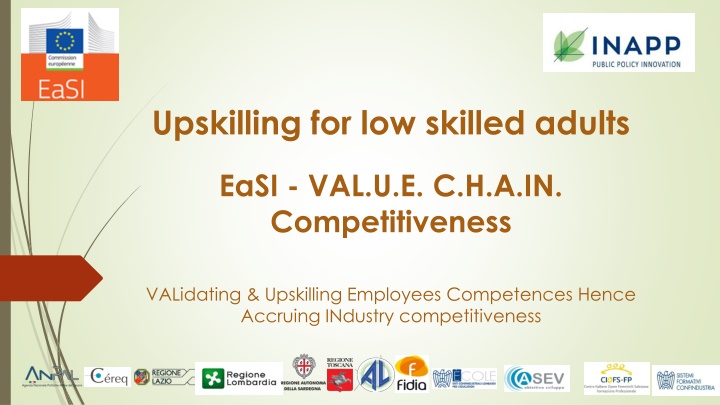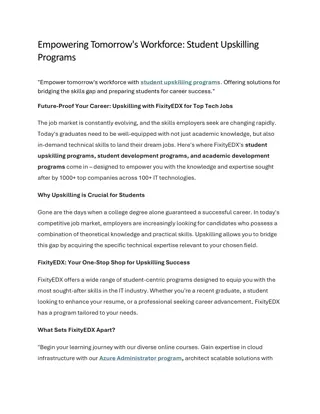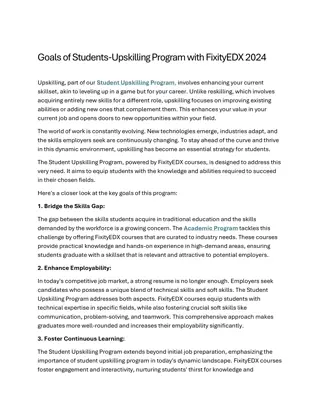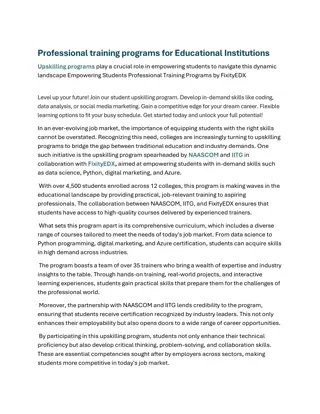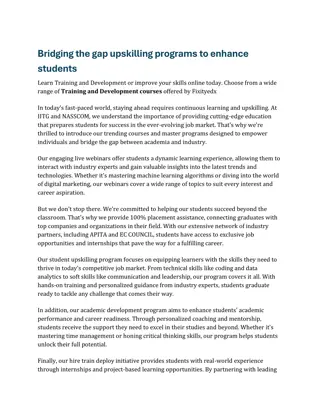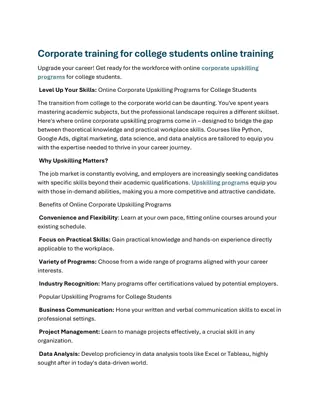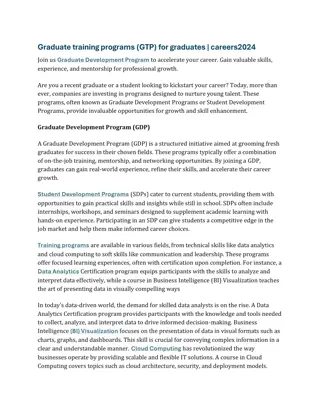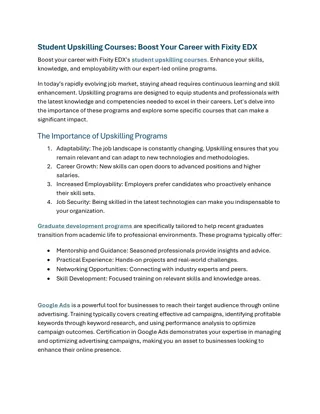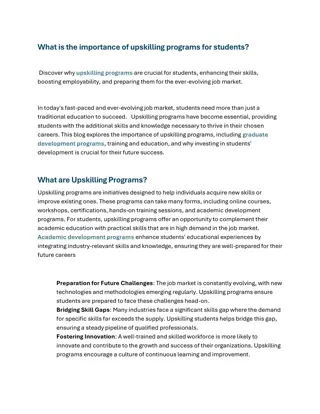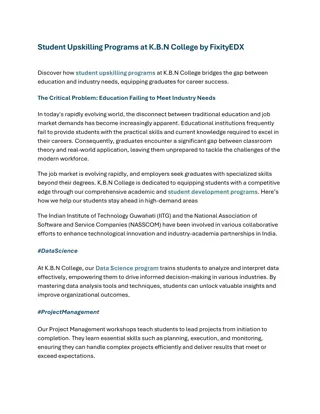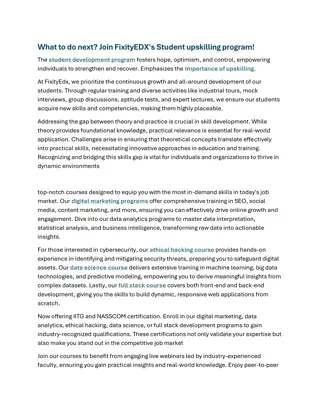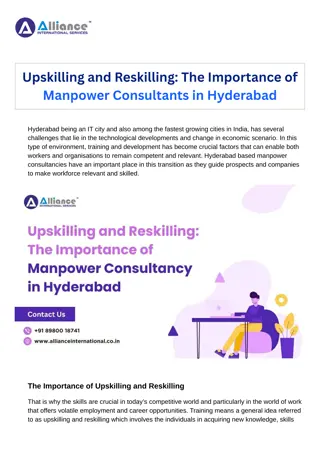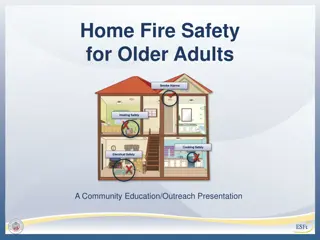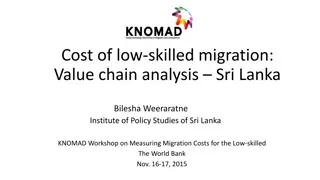Upskilling for low skilled adults
Italy's low ranking in the Digital Economy and Society Index highlights the need to address the lack of digital skills among its population, especially older workers. The project focuses on upskilling and reskilling workers over 50 and those with weak digital qualifications to enhance their competitiveness in the evolving digital landscape. By providing personalized training paths, the project aims to empower adults with essential digital and transversal skills, fostering occupational stability and combating skill obsolescence.
Download Presentation

Please find below an Image/Link to download the presentation.
The content on the website is provided AS IS for your information and personal use only. It may not be sold, licensed, or shared on other websites without obtaining consent from the author.If you encounter any issues during the download, it is possible that the publisher has removed the file from their server.
You are allowed to download the files provided on this website for personal or commercial use, subject to the condition that they are used lawfully. All files are the property of their respective owners.
The content on the website is provided AS IS for your information and personal use only. It may not be sold, licensed, or shared on other websites without obtaining consent from the author.
E N D
Presentation Transcript
Upskilling for low skilled adults EaSI - VAL.U.E. C.H.A.IN. Competitiveness VALidating & Upskilling Employees Competences Hence Accruing INdustry competitiveness
VAL.U.E. C.H.A.IN. Competitiveness: PROJECT RATIONALE AND CONTEXT Italy ranks 25th in Europe in DESI (Digital Economy and Society Index) 2018 and the country belongs to the low performing clusters. In Human Capital in particular, Italy is performing below the average of EU countries: despite the Country is making little progress in terms of Human Capital, the percentage of Internet users has grown from 63% to 67%. in terms of regular Internet users Italy is well below the European share 56% of the individuals aged 16-74 still lacks basic digital skills compared to an EU average of 44%. The lack of these digital skills is caused by two groups of factors: the low level of education of the Italian population and the important share of elderly population.
VAL.U.E. C.H.A.IN. Competitiveness: PROJECT RATIONALE AND CONTEXT the demographic transition in Italy is accentuating the ageing of the population. Italy is the second oldest country in the world, with 168.7 elderly people per 100 young. the average age of those in the labour force tends to gradually increase with important labour market implications. More attention needs to be paid to workers over 50, and in general to older workers considering the combined effect of the steady ageing of the population with the rising retirement age which holds workers longer in the labour market.
VAL.U.E. C.H.A.IN. Competitiveness: PROJECT RATIONALE AND CONTEXT older workers participation in formal education and on-the-job training is lower than that of younger workers, because employers are more reluctant to bear costs of training for workers who are expected to remain for a shorter period of time with their firms Research on learning among older adults shows that they are able to gain new skills but training for this age class might be ineffective if does not meet their specific needs Improving skills of older workers is necessary in order to strengthen the occupational stability of low-qualified and low- skilled people and to avoid the risk of obsolescence of the professionalism of "non-digital natives"
VAL.U.E. C.H.A.IN. Competitiveness: aim and objectives (1/2) the upskilling and reskilling of workers in particular those over 50 years of age, but more generally of adult workers with a weak digital skill/qualification level who are facing digital transformation organizational contexts paths in their the design and delivery of personalized training paths aimed at increasing their knowledge and the acquisition of basic and transversal digital skills;
VAL.U.E. C.H.A.IN. Competitiveness: aim and objectives (2/2) the delivery of training pathways built upon the results of skills assessment processes and on the identification of individual objectives skills assessment procedures and tools are themselves innovative outputs of the project the recognition of the acquired skills, in close cooperation with the Regions and Social Partners and in full compliance with the current legislation: development of processes and devices of validation and this allows to assign a value of use and exchange to the certifications and to match the internal and external labour market needs. In addition, both the assessment processes and the content of the training supply will be based on DG Comp 2.1 standards to ensure established and shared references in the validation and recognition of skills;
VAL.U.E. C.H.A.IN. Competitiveness: aim and objectives full consideration of the outcome of the institutional and scientific debate on the subject in the EU, through the continuous exchange and synergy with existing networks, such as those of the National Co-ordinators of the European Adult Learning Agenda, the other projects funded by the current Call and the two previous ones, the Ambassadors of the EPALE Platform and major international organizations (such as EAEA and EBSN); the raising of greater awareness and knowledge about the long- term benefits for the companies and their main stakeholders (representative associations, trade unions, inter-professional funds, public administrations) when investing on upskilling and reskilling adult workers and in particular those aged over 50.
VAL.U.E. C.H.A.IN. Competitiveness: Work plan 1. SKILLS IDENTIFICATION, VALIDATIONAD RECOGNITION PROCEDURES AND TOOLS 2. LEARNING OUTCOMES DEFINITION FOR BASIC SKILLS 3. INVOLVEMENT AND SELECTION OF ENTERPRISES AND WORKERS (BENEFICIAIRES) 4. DEFINITION OF MODEL AND FORMAT FOR SKILLS TRANSPARENCY CERTIFICATE 5. DEPLOYMENT OF PERSONALIZED UPSKILLING/RESKILLING PATHWAYS FOR WORKERS 6. PROCESSES OF RECOGNITION/CERTIFICATION OF ACQUIRED SKILLS BY TRAINED WORKERS 7. PROJECT MANAGEMENT AND GOVERNANCE 8. DISSEMINATION OF PROJECT OUTPUTS, OUTCOMES AND RESULTS 9. UPSKILLING/RESKILLING INTEGRATED PATHWAYS FOR WORKERS ON DIGITAL BASIC SKILLS: A BENCHMARK EXERCISE WITH FRANCE DEPLOYMENT EXPERIENCES
WP 1: SKILLS IDENTIFICATION, VALIDATION AD RECOGNITION PROCEDURES AND TOOLS The objective is to share with the project partnership, and in particular with the Regions, a common methodology for the recognition of the competences acquired from experience, also in order to recognize credits, before undergoing training and for attending training pathways, towards the training paths, with particular, but not exclusive reference, to digital basic skills. Sub-activity 1.1 Process and share with the Regions the operational model (processes, tools, human resources involved) for identifying basic skills arising from experiences acquired in NFIL contexts; Sub-activity 1.2 - Drafting of IVC model and validation
WP2: LEARNING OUTCOMES DEFINITION FOR BASIC SKILLS The objective of this Work Package is to identify the expected learning outcomes on digital skills and related didactics units starting from: the contents indicated in the European DigiCOMP framework; the methodological approach based on learning outcomes, aimed at facilitating the transfer of qualifications, or of their components, and the learning sequence, as indicated in the Council Recommendation on the European Qualifications Framework for EQF lifelong learning of 22 May 2017; the proposal drawn up, at national level, in the institutional process for the implementation of the national system for the certification of competences. The expected result of this WP is the definition of a reference model for the expected learning outcomes on basic and intermediate digital skills. The aim is therefore to create a first reference tool for the assessment of digital skills, common to the different Regions involved in the partnership, to be tested in the experimental phases of the project with the target group of identified workers and to be valorised at the end of the project, in the work of implementing the National Qualifications Repertory and the National Qualifications Framework. Sub activity 2.1 - Definition of Learning Outcomes (Basic digital skills) Sub activity 2.2 - related didactical Units from DIGICOMP 2.1 European Framework Sub activity 2.3 - Definition of module and training unit contents and didactical methodologies
WP3: INVOLVEMENT AND SELECTION OF ENTERPRISES AND WORKERS (BENEFICIAIRES) The WP is aimed at identifying the sample of workers to be involved in the experimental phases of the project. Considering the problem of the obsolescence of skills, as well as the impact of technological innovation, workers over 50 constitute a privileged group to be addressed for their being a more sensitive target with respect to process innovation and changes in work tasks and for the consequent need to develop basic digital skills. The intervention will primarily concern employees who perform routine tasks. The sample will be stratified also on the basis of sectorial references, with an attention focused first on those contexts considered to be more exposed to technological innovation. Moreover, illiteracy situations, especially but not exclusively digital ones, will be taken into consideration even for individuals of different ages and with different contractual frameworks but with specific needs, such as micro and small business entrepreneurs. Sub-activity 3.1 - selection of potential enterprises to involve and co-operation agreement signature Sub-activity 3.2 Recruitment and first selection of workers
WP4: DEFINITION OF MODEL AND FORMAT FOR SKILLS TRANSPARENCY CERTIFICATE The objective of this WP is to define and experiment the process leading to draw up an innovative tool to record the skills possessed by workers, with particular reference to those that did not entail obtaining a formal education or training qualification. In the new Skills Transparency Certificate, training, work and life experiences carried out by workers over the last ten years only will be considered and described, and this also because of the rapid obsolescence of the concerned competences. The WP4 will be integrated by an information / training activity led by INAPP and ANPAL for the benefit of the operators involved in the experimentation, also in order to align the information about the outcomes of the methodologies and tools developed in the previous WP1 and WP2 Sub-activity 4.1 - Analysis of existing tools to recognize and certificate skills Sub-activity 4.2 - Composition of a skills transparency certificate
WP5: DEPLOYMENT OF PERSONALIZED UPSKILLING/RESKILLING PATHWAYS FOR WORKERS The WP provides for training sessions of the beneficiaries involved, the contents of which will be defined to fill the assessed individual skills gaps. The action will be addressed at no less than 300 workers, a number that could be higher where the companies of origin allow the involvement of more employees. It should also be noted that although the sectors identified at the design stage are essentially manufacturing and services, it is not excluded that - as a result of a sectorial needs analysis - other sectors can be considered as a pool for the recruitment of beneficiaries. The sectorial origin of workers has an impact on the personalization and adaptation of the training offer to beneficiaries individual needs. The training activities will be carried out as defined and shared in the personalized training paths, with reference to the Units of expected learning outcomes identified above all - but not only relatively to basic digital skills. The delivery of the Skills Transparency Certificate to each learner involved and, at the end of the training path, of a certification for acquired learning outcomes will facilitate the portability and the recognition in case of sectorial or territorial mobility of the worker. Full consideration of diverse cognitive styles, adapting didactical methodologies, learning settings and didactical tools to the individual characteristics (trainability). Sub-activity 5.1 - Skills assessment of selected workers and recognition/validation of prior learning Sub-activity 5.2 - Definition of personalized training paths according to individual skills gap and newly standardized skills requirements AND definition (where possible) of homogeneous training class-groups Sub-activity 5.3 - Upskilling/reskilling pathways delivery
WP6: PROCESSES OF RECOGNITION/CERTIFICATION OF ACQUIRED SKILLS BY TRAINED WORKERS The WP concludes the experimentation of the intervention which included the training action between the phases of skills audit and those of valorisation of the skills acquired at the end of training. The objective is two-fold: first, to ensure that involved workers get the maximum benefit from participation in the project, guaranteeing them not only the acquisition of those useful and functional skills to progress in their professional career in the firm with better opportunities for inclusion in new production processes, but also the provision of a certificate which, in perspective, can support the acquisition of a higher level of professional qualification; secondly, to demonstrate the effectiveness of an integrated intervention, fully compliant with quality standards and consistent with the procedures established by a legislation that still needs to be fully implemented. Sub-activity 6.1 - Assessment testing to validate the LO of trained workers Sub-activity 6.2 - Delivery of the skills transparency certificate
WP7: PROJECT MANAGEMENT AND GOVERNANCE Sub-activity 7.1 - Administrative MGT, development of guidelines for project MGT and internal communication tools, internal monitoring and evaluation, Risk MGT. Sub-activity 7.2 - Drafting progress and finalReports Sub-activity 7.3 - Steering committee: role activities and meetings Sub-activity 7.4 - Technical Scientific Committee: role activities and meetings Expected outputs/deliverable D7.1 Quality Plan D7.2 Risk assessment Chart D7.3 Monitoring/evaluation Plan D7.4 Progress Report D7.5 Final Report D7.6 6 steering committee meetings D7.7 6 technical Scientific Committee meetings
WP8: DISSEMINATION OF PROJECT OUTPUTS, OUTCOMES AND RESULTS This work package contributes to informing stakeholders on the activities carried out within the action, systematizing and disseminating deliverables and, in so doing,: - raising the awareness among relevant stakeholders on the UP and how they can directly contribute to its implementation - improving their capacity to implement UP Recommendation; - ensuring a proactive involvement of relevant actors in the implementation of the action. The action adopts a diversified and multi-agent approach to dissemination and awareness raising by envisaging different activities and developing a range of tools based on deliverables of different Wps. Specific objectives of this WP are listed as follows: - develop tailored dissemination and guidance tools for each WP1,WP2, WP4, WP6; - proactively involving relevant stakeholders, line institutions, local authorities, social partners, training providers, Employers; - to share and to discuss project results among the scientific community; - support outreach activities of UP stakeholders The communication campaign targets operators through the institutional web pages and the channels used by the major stakeholders, such as: employment services; the Permanent Territorial Centers for Adult Education; Trade Unions and employers organizations; guidance centers; Eurodirect centers; accredited training providers, etc.. Sub - activity 8.1: Dissemination Plan Sub - activity 8.2: implementation of existing institutional partners websites Sub - activity 8.3: production of an online newsletter Sub - activity 8.4: organization/participation in at least 5 regional dissemination seminars Sub - activity 8.5: Final conference
WP9: UPSKILLING/RESKILLING INTEGRATED PATHWAYS FOR WORKERS ON DIGITAL BASIC SKILLS: A BENCHMARK EXERCISE WITH FRANCE DEPLOYMENT EXPERIENCES Italy and France are facing a period of important reforms and innovation in their education and training systems. Bothcountries are experiencing high rates of functional illiteracy, with a high number of low-skilled adults. Given the target group of beneficiaries identified in the project VAL.U.E. C.H.A.IN. Competitiveness, it is of common interest to focus the cooperation starting from the analysis of the responses identified by the French system to improve the performance of its CVET offer, in particular with respect to the digital skills of workers. An additional topic for analysis concerns the governance of the system of CVET offer, which in France too is featured by a multiplayer and multilevel dimension and has undergone deep changes in the latest months.
